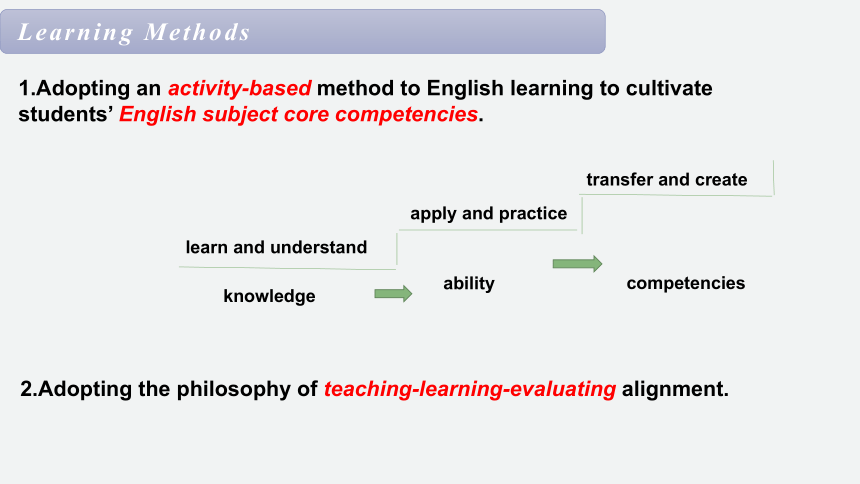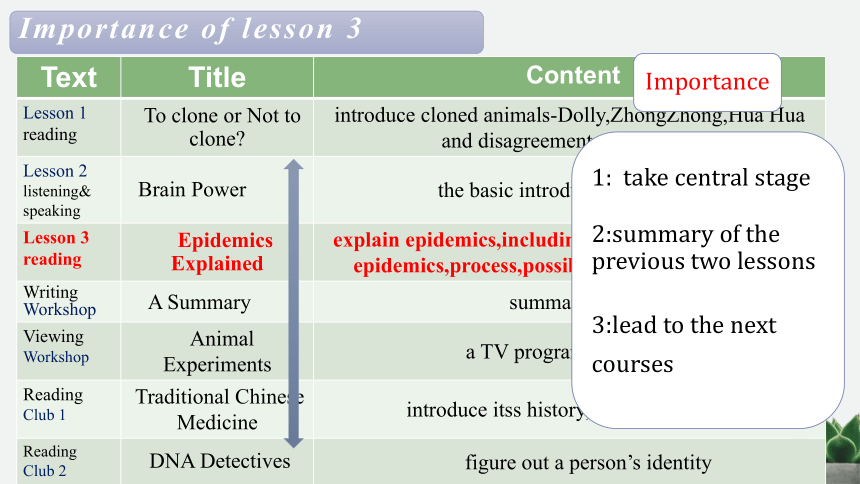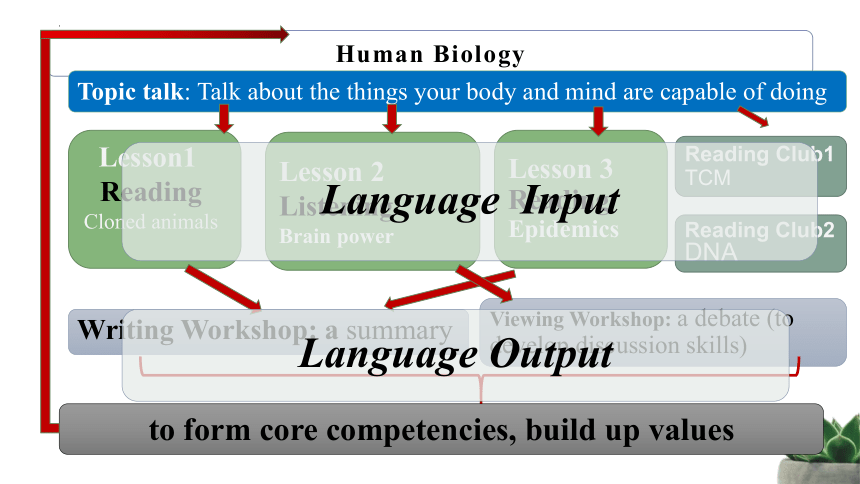北师大版(2019)选择性必修第三册Unit 9 Lesson 3 Epidemics Explained 说课课件 (共39张PPT)
文档属性
| 名称 | 北师大版(2019)选择性必修第三册Unit 9 Lesson 3 Epidemics Explained 说课课件 (共39张PPT) |  | |
| 格式 | pptx | ||
| 文件大小 | 32.3MB | ||
| 资源类型 | 教案 | ||
| 版本资源 | 北师大版(2019) | ||
| 科目 | 英语 | ||
| 更新时间 | 2023-07-14 11:05:19 | ||
图片预览












文档简介
(共39张PPT)
Unit 9 Human Biology
Lesson 3 Epidemics Explanied
2
Materical Analysis
03
04
05
Contents
General Design Idea
02
01
Learners Analysis
Teaching Reflection
Teaching Steps
06
Blackboard Design
General Design Idea
Theories
01
普通高中英语课程标准对英语教学的要求
《英语课程标准》指出,"新一轮英语课程改革的重点就是要改变英语课程过分重视语法和词汇知识的讲解与传授、重视对学生实际语言运用能力培养的倾向,强调课程从学生的学习兴趣、生活经验和认知水平出发,倡导体验、实践、参与、合作与交流的学习方式和任务型的教学途径,发展学生的综合语言运用能力,使学习的过程成为学生形成积极的情感体验、主动思维、大胆实践,提高跨文化意识和形成自主学习能力 的过程。
《课程标准解析与教学指导》对高中阶段英语阅读技能目标提出如下要求:
·找出作者要传达的主要信息;
·按要求辨认语言结构、内容、事物发展顺序;
·辨识内涵的主旨或观念;
·辨认、辨识、比较事实、证据和观点以及定义和假设性信息;
·对事实和证据进行评价,判断和预测;
·根据文中所提供的事实和证据得出结论;
·进行逻辑推断等:
Teaching Aims
Teaching Activities
Teaching Evaluation
Teaching Methods
General Design Idea
Six Key Elements
learn and understand---apply and
practice---migrate and create
“Teaching-Learning-Evaluating”
“activity-based”
Learning Methods
1.Adopting an activity-based method to English learning to cultivate students’ English subject core competencies.
learn and understand
knowledge
apply and practice
ability
transfer and create
competencies
2.Adopting the philosophy of teaching-learning-evaluating alignment.
Materical Analysis
02
theme
9
genetics,clone,evolution,
ecology,also inclduing
unit
contents
teaching and learning
Human Biology
Epidemics
Explained
Theme Analysis
Unit 9
Lesson 3
Text Title Content
Lesson 1 reading To clone or Not to clone introduce cloned animals-Dolly,ZhongZhong,Hua Hua and disagreement about clone
Lesson 2 listening& speaking Brain Power the basic introduction of human brain
Lesson 3 reading Epidemics Explained explain epidemics,including origin,type,examples of epidemics,process,possible causes and solutions
Writing Workshop A Summary summary writing
Viewing Workshop Animal Experiments a TV programme and debate
Reading Club 1 Traditional Chinese Medicine introduce itss history,belief and treatments
Reading Club 2 DNA Detectives figure out a person’s identity
Importance
1: take central stage
2:summary of the previous two lessons
3:lead to the next courses
Importance of lesson 3
Human Biology
Topic talk: Talk about the things your body and mind are capable of doing
Lesson 2
Listening
Brain power
Lesson 3
Reading
Epidemics
Lesson1
Reading
Cloned animals
Writing Workshop: a summary
Viewing Workshop: a debate (to develop discussion skills)
to form core competencies, build up values
Reading Club1
TCM
Reading Club2
DNA
Language Input
Language Output
Materials of lesson 3
what
theme
content
epidemics
Introduce some information about epidemics
why
1.Call for students to pay attention to the epidemics.
2.Stress the importance to live happily and healthily.
how
text type
argumentation
structure
introduction-argumentation-conclusion
language
feature
Use examples and evidence as supporting details
Materials of lesson 3
1.too many reading materials
(9 paras,3 parts)
2.many new words and long difficult sentences
(infectious,deserve,systematic,
attributive clause)
3.much grammatical knowledge
(past participle,present perfect)
4.many learning tasks
(eight exercises)
Key and Difficult Points
Key Points Solutions
1.sort out the different kinds of epidemics 2.distinguish topic sentences from details 1.situation of a forum
2.graphic organizer
3.tips
Difficult Point Solution
debate on the author’s point of view scaffold for the content,structure,peers
Learning Objectives
During the class,students will be able to:
1.sort out the information about epidemics,in terms of causes,influences,classification and solutions
2.Identify and summarize the structure of lesson 3
3.Extract useful sentence patterns from the text
4.Report on the issue of epidemics on school English forum
Learners
03
What they have
What they lack
1 cooperation and willingness to learn
2 a certain amount of vocabulary to describe human biology
3 basic language skills
1 active exploration
2 a clear idea about context
3 how to express their own ideas vividly and logically
Analysis of Learners
Teaching Steps
04
Teaching Steps
Step 1 Warm up & Lead in
1.Greetings
2.Show a video about COVID-19,after showing,ask students what can we learn from this video.
And then pick out some important words or phrases in the video.
Teaching Steps
Step 2 Pre-reading
Ask students to pay attention to the title and pictures, to predict the main idea of this lesson.
Step 3 while-reading
1.Ask students to read the text quickly,especially the first sentence of each paragraph,to check the main idea of text.
Teaching Steps
Para.1 An epidemics is the name given to an infectious disease that.....
Para.2 Each disease can only officially be classified as an eidemics once...
Para.3 With recent pressmreports drawing pallels between...
Para.4 Since bird flu first appeared in 1997, it has taken more than...
Para.5 One of the earliest epidemics on record happened between...
Para.6 Centuries later, the Great Flu Epidemic of 1918....
Para.7 The SARS epidemic began in 2002 with a case of lung disease...
Para.8 Then,from 2013 to 2019,there was the most widespread outbreak...
Para.9 Despite, or perhaps because of.....
2.Tick(√)the aspects of imformation that are mentioned in the passage.
(√)when epidemics started (√)definition
(√)examples of epidemics (√)when it ended
(√)possible causes of epidemics ( )treatments
( )baseline number of deaths of epidemics
(√)possible solutions
Name Period Places Death toll
Bird Flu 1997 / caused over 100 deaths
Epidemics in the Roman Empire 500~520CE Roman Empire up to 50% of the area’s population died
The Black Death 1330s Asia,Europe /
The Spanish Flu near the end of World War 1 / caused up to 50 million deaths in 18 months
SARS began in 2002 and lasted untill 2003 China,Canada, Vietnam,Singapore /
EVD from 2013 to 2016 West Afica more than 11,310 deaths
3.Read the passage again.Complete the table about epidemics mentioned. Then choose one disease to talk about with a partner.
4.True or False
(T) An epidemics is the rapid spread of an infectious disease.
(F) An epidemics can affect a large number of people in a given population.
(T) An epidemics can occur with a short period of time,usually two weeks or less.
(T) An epidemics may spread to several countries or continents.
(F) Some common viruses,such as the common cold,are not epidemics.
(T) A new epidemic can be a different variation of a virus that people caught in th past.
Teaching Steps&Aims
Step 4 Post-reading
1.Read again and retell the text in groups.
2.After retelling,discuss the questions.
①What are the main features of an epidemic Give at least two examples to illustrate your points.
It is an infectious disease
It spreads rapidly to a large number of people within a short period of time.
③What does the title mean to you What does the writer want to convey in the passage
The title means that the passage will explain questions about epidemics.The writer wants to convey the information that we are always on our way to find an explanation to epidemics so as to find cure.
④Who do you think the passage is written for
It is more likely to be written for people who is interested in this topic or who has a lot of questions or misunderstanding of epidemics.
②What should different countries do to prevent outbreaks of epidemics in the future Why
Countries will need to work together to do this because teamwork among nations across the globe can save lives.
Teaching Steps&Aims
Step 5 Summary
An epidemics is the name given to an infectious disease that rapidly spreads to a large number of people within a short period of time.Epidemics have been happened for as long as there have been people living on earth.
Each disease can only officially be classified as an epidemics once a certain number of deaths have occurred from the disease.The common cold is a widespread virus that affects millions of people,but it is not seen as being a serious enough condition to deserve the classification of epidemics.
Despite,or perhaps because of,the epidemics the world has faced in recent years,governments worldwide have underlined the fact that they want thorough and systematic medical research on epidemics to get at the causes and come up with cures as soon as possible.Countries will need to work together to do this because teamwork among nations across the globe can save lives.
EVD resulted in a major loss of life in a number of west African countries.11,310 deaths were officiallly recorded,but the actual number of deaths is probabaly much higher.The virus was extremely infectious and the survival rate was as low as 30% in some areas.
Teaching Steps
Step 6 Voice their opinion
1.Work in pairs and have a discussion.
①If you were a reporter,what will you interview a specialist on epidemics
②If you were an officer,what can you do to help people prevent epidemics
③As a student,how has the epidemics affected you
2.After discussion, invite some students to play a role.
3.After role play ,ask students if there is anything that impresses us about the epidemics
Teaching Steps
Step 6 Voice their opinion
Homework Design
continue writing a paragraph
make a poster
write a summary
talk with others
preview next lesson
composition contest
prepare a speech
Lesson 3
Teaching Reflection
05
Teaching Reflection
1.Adopting an activity-based approach to English learning and promoting the cultivation of English subject core competencies.
2.Implementing integration of teaching,learning and evaluating.
3.Adopting backward design.
4.Teaching by using the textbook,not teaching the textbook.
Blackboard Design
06
Blackboard Design
Blackboard Design
Blackboard Design
THANKS~
Unit 9 Human Biology
Lesson 3 Epidemics Explanied
2
Materical Analysis
03
04
05
Contents
General Design Idea
02
01
Learners Analysis
Teaching Reflection
Teaching Steps
06
Blackboard Design
General Design Idea
Theories
01
普通高中英语课程标准对英语教学的要求
《英语课程标准》指出,"新一轮英语课程改革的重点就是要改变英语课程过分重视语法和词汇知识的讲解与传授、重视对学生实际语言运用能力培养的倾向,强调课程从学生的学习兴趣、生活经验和认知水平出发,倡导体验、实践、参与、合作与交流的学习方式和任务型的教学途径,发展学生的综合语言运用能力,使学习的过程成为学生形成积极的情感体验、主动思维、大胆实践,提高跨文化意识和形成自主学习能力 的过程。
《课程标准解析与教学指导》对高中阶段英语阅读技能目标提出如下要求:
·找出作者要传达的主要信息;
·按要求辨认语言结构、内容、事物发展顺序;
·辨识内涵的主旨或观念;
·辨认、辨识、比较事实、证据和观点以及定义和假设性信息;
·对事实和证据进行评价,判断和预测;
·根据文中所提供的事实和证据得出结论;
·进行逻辑推断等:
Teaching Aims
Teaching Activities
Teaching Evaluation
Teaching Methods
General Design Idea
Six Key Elements
learn and understand---apply and
practice---migrate and create
“Teaching-Learning-Evaluating”
“activity-based”
Learning Methods
1.Adopting an activity-based method to English learning to cultivate students’ English subject core competencies.
learn and understand
knowledge
apply and practice
ability
transfer and create
competencies
2.Adopting the philosophy of teaching-learning-evaluating alignment.
Materical Analysis
02
theme
9
genetics,clone,evolution,
ecology,also inclduing
unit
contents
teaching and learning
Human Biology
Epidemics
Explained
Theme Analysis
Unit 9
Lesson 3
Text Title Content
Lesson 1 reading To clone or Not to clone introduce cloned animals-Dolly,ZhongZhong,Hua Hua and disagreement about clone
Lesson 2 listening& speaking Brain Power the basic introduction of human brain
Lesson 3 reading Epidemics Explained explain epidemics,including origin,type,examples of epidemics,process,possible causes and solutions
Writing Workshop A Summary summary writing
Viewing Workshop Animal Experiments a TV programme and debate
Reading Club 1 Traditional Chinese Medicine introduce itss history,belief and treatments
Reading Club 2 DNA Detectives figure out a person’s identity
Importance
1: take central stage
2:summary of the previous two lessons
3:lead to the next courses
Importance of lesson 3
Human Biology
Topic talk: Talk about the things your body and mind are capable of doing
Lesson 2
Listening
Brain power
Lesson 3
Reading
Epidemics
Lesson1
Reading
Cloned animals
Writing Workshop: a summary
Viewing Workshop: a debate (to develop discussion skills)
to form core competencies, build up values
Reading Club1
TCM
Reading Club2
DNA
Language Input
Language Output
Materials of lesson 3
what
theme
content
epidemics
Introduce some information about epidemics
why
1.Call for students to pay attention to the epidemics.
2.Stress the importance to live happily and healthily.
how
text type
argumentation
structure
introduction-argumentation-conclusion
language
feature
Use examples and evidence as supporting details
Materials of lesson 3
1.too many reading materials
(9 paras,3 parts)
2.many new words and long difficult sentences
(infectious,deserve,systematic,
attributive clause)
3.much grammatical knowledge
(past participle,present perfect)
4.many learning tasks
(eight exercises)
Key and Difficult Points
Key Points Solutions
1.sort out the different kinds of epidemics 2.distinguish topic sentences from details 1.situation of a forum
2.graphic organizer
3.tips
Difficult Point Solution
debate on the author’s point of view scaffold for the content,structure,peers
Learning Objectives
During the class,students will be able to:
1.sort out the information about epidemics,in terms of causes,influences,classification and solutions
2.Identify and summarize the structure of lesson 3
3.Extract useful sentence patterns from the text
4.Report on the issue of epidemics on school English forum
Learners
03
What they have
What they lack
1 cooperation and willingness to learn
2 a certain amount of vocabulary to describe human biology
3 basic language skills
1 active exploration
2 a clear idea about context
3 how to express their own ideas vividly and logically
Analysis of Learners
Teaching Steps
04
Teaching Steps
Step 1 Warm up & Lead in
1.Greetings
2.Show a video about COVID-19,after showing,ask students what can we learn from this video.
And then pick out some important words or phrases in the video.
Teaching Steps
Step 2 Pre-reading
Ask students to pay attention to the title and pictures, to predict the main idea of this lesson.
Step 3 while-reading
1.Ask students to read the text quickly,especially the first sentence of each paragraph,to check the main idea of text.
Teaching Steps
Para.1 An epidemics is the name given to an infectious disease that.....
Para.2 Each disease can only officially be classified as an eidemics once...
Para.3 With recent pressmreports drawing pallels between...
Para.4 Since bird flu first appeared in 1997, it has taken more than...
Para.5 One of the earliest epidemics on record happened between...
Para.6 Centuries later, the Great Flu Epidemic of 1918....
Para.7 The SARS epidemic began in 2002 with a case of lung disease...
Para.8 Then,from 2013 to 2019,there was the most widespread outbreak...
Para.9 Despite, or perhaps because of.....
2.Tick(√)the aspects of imformation that are mentioned in the passage.
(√)when epidemics started (√)definition
(√)examples of epidemics (√)when it ended
(√)possible causes of epidemics ( )treatments
( )baseline number of deaths of epidemics
(√)possible solutions
Name Period Places Death toll
Bird Flu 1997 / caused over 100 deaths
Epidemics in the Roman Empire 500~520CE Roman Empire up to 50% of the area’s population died
The Black Death 1330s Asia,Europe /
The Spanish Flu near the end of World War 1 / caused up to 50 million deaths in 18 months
SARS began in 2002 and lasted untill 2003 China,Canada, Vietnam,Singapore /
EVD from 2013 to 2016 West Afica more than 11,310 deaths
3.Read the passage again.Complete the table about epidemics mentioned. Then choose one disease to talk about with a partner.
4.True or False
(T) An epidemics is the rapid spread of an infectious disease.
(F) An epidemics can affect a large number of people in a given population.
(T) An epidemics can occur with a short period of time,usually two weeks or less.
(T) An epidemics may spread to several countries or continents.
(F) Some common viruses,such as the common cold,are not epidemics.
(T) A new epidemic can be a different variation of a virus that people caught in th past.
Teaching Steps&Aims
Step 4 Post-reading
1.Read again and retell the text in groups.
2.After retelling,discuss the questions.
①What are the main features of an epidemic Give at least two examples to illustrate your points.
It is an infectious disease
It spreads rapidly to a large number of people within a short period of time.
③What does the title mean to you What does the writer want to convey in the passage
The title means that the passage will explain questions about epidemics.The writer wants to convey the information that we are always on our way to find an explanation to epidemics so as to find cure.
④Who do you think the passage is written for
It is more likely to be written for people who is interested in this topic or who has a lot of questions or misunderstanding of epidemics.
②What should different countries do to prevent outbreaks of epidemics in the future Why
Countries will need to work together to do this because teamwork among nations across the globe can save lives.
Teaching Steps&Aims
Step 5 Summary
An epidemics is the name given to an infectious disease that rapidly spreads to a large number of people within a short period of time.Epidemics have been happened for as long as there have been people living on earth.
Each disease can only officially be classified as an epidemics once a certain number of deaths have occurred from the disease.The common cold is a widespread virus that affects millions of people,but it is not seen as being a serious enough condition to deserve the classification of epidemics.
Despite,or perhaps because of,the epidemics the world has faced in recent years,governments worldwide have underlined the fact that they want thorough and systematic medical research on epidemics to get at the causes and come up with cures as soon as possible.Countries will need to work together to do this because teamwork among nations across the globe can save lives.
EVD resulted in a major loss of life in a number of west African countries.11,310 deaths were officiallly recorded,but the actual number of deaths is probabaly much higher.The virus was extremely infectious and the survival rate was as low as 30% in some areas.
Teaching Steps
Step 6 Voice their opinion
1.Work in pairs and have a discussion.
①If you were a reporter,what will you interview a specialist on epidemics
②If you were an officer,what can you do to help people prevent epidemics
③As a student,how has the epidemics affected you
2.After discussion, invite some students to play a role.
3.After role play ,ask students if there is anything that impresses us about the epidemics
Teaching Steps
Step 6 Voice their opinion
Homework Design
continue writing a paragraph
make a poster
write a summary
talk with others
preview next lesson
composition contest
prepare a speech
Lesson 3
Teaching Reflection
05
Teaching Reflection
1.Adopting an activity-based approach to English learning and promoting the cultivation of English subject core competencies.
2.Implementing integration of teaching,learning and evaluating.
3.Adopting backward design.
4.Teaching by using the textbook,not teaching the textbook.
Blackboard Design
06
Blackboard Design
Blackboard Design
Blackboard Design
THANKS~
